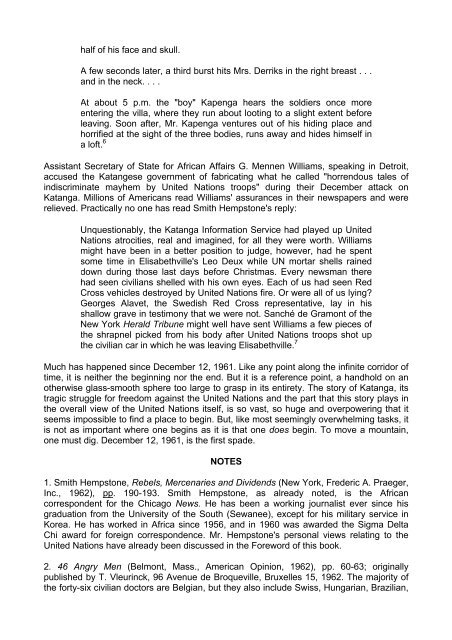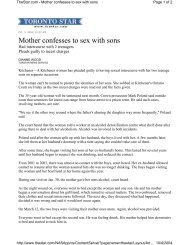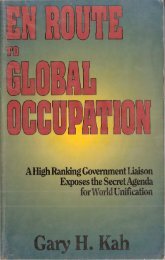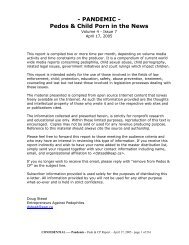G. Edward Griffin - The Fearful Master - PDF Archive
G. Edward Griffin - The Fearful Master - PDF Archive
G. Edward Griffin - The Fearful Master - PDF Archive
You also want an ePaper? Increase the reach of your titles
YUMPU automatically turns print PDFs into web optimized ePapers that Google loves.
half of his face and skull.<br />
A few seconds later, a third burst hits Mrs. Derriks in the right breast . . .<br />
and in the neck. . . .<br />
At about 5 p.m. the "boy" Kapenga hears the soldiers once more<br />
entering the villa, where they run about looting to a slight extent before<br />
leaving. Soon after, Mr. Kapenga ventures out of his hiding place and<br />
horrified at the sight of the three bodies, runs away and hides himself in<br />
a loft. 6<br />
Assistant Secretary of State for African Affairs G. Mennen Williams, speaking in Detroit,<br />
accused the Katangese government of fabricating what he called "horrendous tales of<br />
indiscriminate mayhem by United Nations troops" during their December attack on<br />
Katanga. Millions of Americans read Williams' assurances in their newspapers and were<br />
relieved. Practically no one has read Smith Hempstone's reply:<br />
Unquestionably, the Katanga Information Service had played up United<br />
Nations atrocities, real and imagined, for all they were worth. Williams<br />
might have been in a better position to judge, however, had he spent<br />
some time in Elisabethville's Leo Deux while UN mortar shells rained<br />
down during those last days before Christmas. Every newsman there<br />
had seen civilians shelled with his own eyes. Each of us had seen Red<br />
Cross vehicles destroyed by United Nations fire. Or were all of us lying?<br />
Georges Alavet, the Swedish Red Cross representative, lay in his<br />
shallow grave in testimony that we were not. Sanché de Gramont of the<br />
New York Herald Tribune might well have sent Williams a few pieces of<br />
the shrapnel picked from his body after United Nations troops shot up<br />
the civilian car in which he was leaving Elisabethville. 7<br />
Much has happened since December 12, 1961. Like any point along the infinite corridor of<br />
time, it is neither the beginning nor the end. But it is a reference point, a handhold on an<br />
otherwise glass-smooth sphere too large to grasp in its entirety. <strong>The</strong> story of Katanga, its<br />
tragic struggle for freedom against the United Nations and the part that this story plays in<br />
the overall view of the United Nations itself, is so vast, so huge and overpowering that it<br />
seems impossible to find a place to begin. But, like most seemingly overwhelming tasks, it<br />
is not as important where one begins as it is that one does begin. To move a mountain,<br />
one must dig. December 12, 1961, is the first spade.<br />
NOTES<br />
1. Smith Hempstone, Rebels, Mercenaries and Dividends (New York, Frederic A. Praeger,<br />
Inc., 1962), pp. 190-193. Smith Hempstone, as already noted, is the African<br />
correspondent for the Chicago News. He has been a working journalist ever since his<br />
graduation from the University of the South (Sewanee), except for his military service in<br />
Korea. He has worked in Africa since 1956, and in 1960 was awarded the Sigma Delta<br />
Chi award for foreign correspondence. Mr. Hempstone's personal views relating to the<br />
United Nations have already been discussed in the Foreword of this book.<br />
2. 46 Angry Men (Belmont, Mass., American Opinion, 1962), pp. 60-63; originally<br />
published by T. Vleurinck, 96 Avenue de Broqueville, Bruxelles 15, 1962. <strong>The</strong> majority of<br />
the forty-six civilian doctors are Belgian, but they also include Swiss, Hungarian, Brazilian,



![Robert T McQuaid [rtmq@stn.net] Sent: Friday, October 29, 2004 12 ...](https://img.yumpu.com/51070071/1/190x245/robert-t-mcquaid-rtmqstnnet-sent-friday-october-29-2004-12-.jpg?quality=85)







